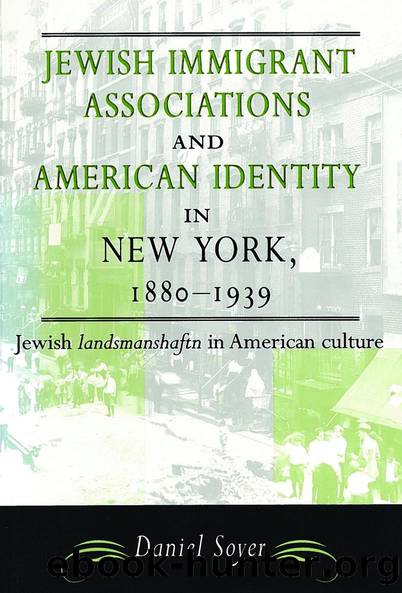Jewish Immigrant Associations and American Identity in New York, 1880-1939 by Daniel Soyer

Author:Daniel Soyer [Soyer, Daniel]
Language: eng
Format: epub
Tags: Social Science, Emigration & Immigration, History, United States, 19th Century, Jewish Studies
ISBN: 9780814344514
Google: jphwDwAAQBAJ
Publisher: Wayne State University Press
Published: 2018-02-05T05:23:38+00:00
7
The Heroic Period
World War I was a pivotal moment in the history of the landsmanshaftn, as it was in the history of Jewry as a whole. Some three quarters of all Jews lived in the belligerent countries, and much of the fighting took place in areas of heavy Jewish concentration in Eastern and East Central Europe. The battles themselves, the economic dislocation of the war, and violence directed specifically against the Jewish population all combined to take a heavy toll on the towns and cities whose names the American landsmanshaftn bore. Hundreds of thousands were uprooted, making their way to the large cities and the interiors of the Russian and Austro-Hungarian empires. Economic losses reached an estimated $400,000,000.1 Moreover, the crisis extended beyond 1918, as the Russian Civil War and war between the new Soviet and Polish states continued into the 1920s.
The landsmanshaftn responded by organizing to provide massive amounts of aid to their unfortunate landslayt. This was, in the words of social critic Borukh Rivkin, their âheroic period.â Societies now devoted the full range of their activities to raising money for overseas relief. Between 1914 and 1924 they sent millions of dollars to their European brothers and sisters. The increase in activity around relief work sometimes breathed new life into flagging societies. Some immigrants even founded new associations in response to events in Europe.2
The landsmanshaft activity was only part of the extensive relief effort undertaken by American Jewry during and after World War I. Organizations such as the Joint Distribution Committee of the American Funds for Jewish War Sufferers (JDC or Joint), formed in the early days of the war to provide emergency relief, developed into permanent bodies with a commitment to the Progressive Eraâs ideal of social-welfare professionalism. The landsmanshaftn often supported the general relief agencies, but relations between them were tense. The former maintained an emotional attachment to their hometowns and sometimes resented the air of bureaucratic aloofness of the central agencies. The JDC, for its part, considered the hometown associations to be important potential partners, but at the same time it strove to control what it viewed as a chaotic, wasteful, and amateurish landsmanshaft sector.
Despite these differences, the landsmanshaftn and the Joint displayed significant similarities in their approaches to overseas relief. Most importantly, the war crisis brought an unprecedented degree of unity among previously hostile segments of the Jewish community. The JDC itself was a coalition of âuptownâ and âdowntownâ Jews, of radicals, conservatives, and professional communal workers. On the landsmanshaft level, hitherto competing organizations from the same town banded together in united relief committees to assist their beleaguered landslayt. Moreover, the professional agency and the societies alike sought to impose this very American sense of nonpartisan pragmatism on the ideologically charged and highly factionalized Jewish communities of Eastern Europe.
Overseas relief work, which since World War I has been a defining characteristic of American Jewry, provided the medium through which the landslayt demonstrated both a new sense of Americanism and a more explicit concern for their old hometowns than they had previously displayed.
Download
This site does not store any files on its server. We only index and link to content provided by other sites. Please contact the content providers to delete copyright contents if any and email us, we'll remove relevant links or contents immediately.
| Africa | Americas |
| Arctic & Antarctica | Asia |
| Australia & Oceania | Europe |
| Middle East | Russia |
| United States | World |
| Ancient Civilizations | Military |
| Historical Study & Educational Resources |
Machine Learning at Scale with H2O by Gregory Keys | David Whiting(4167)
Never by Ken Follett(3786)
Fairy Tale by Stephen King(3216)
The Man Who Died Twice by Richard Osman(2995)
Oathbringer (The Stormlight Archive, Book 3) by Brandon Sanderson(2870)
Will by Will Smith(2788)
Rationality by Steven Pinker(2290)
The Dark Hours by Michael Connelly(2242)
Can't Hurt Me: Master Your Mind and Defy the Odds - Clean Edition by David Goggins(2224)
The Dawn of Everything: A New History of Humanity by David Graeber & David Wengrow(2122)
Friends, Lovers, and the Big Terrible Thing by Matthew Perry(2116)
Principles for Dealing With the Changing World Order: Why Nations Succeed and Fail by Ray Dalio(1969)
HBR's 10 Must Reads 2022 by Harvard Business Review(1776)
A Short History of War by Jeremy Black(1758)
Go Tell the Bees That I Am Gone by Diana Gabaldon(1684)
515945210 by Unknown(1597)
A Game of Thrones (The Illustrated Edition) by George R. R. Martin(1585)
Kingdom of Ash by Maas Sarah J(1518)
443319537 by Unknown(1465)
